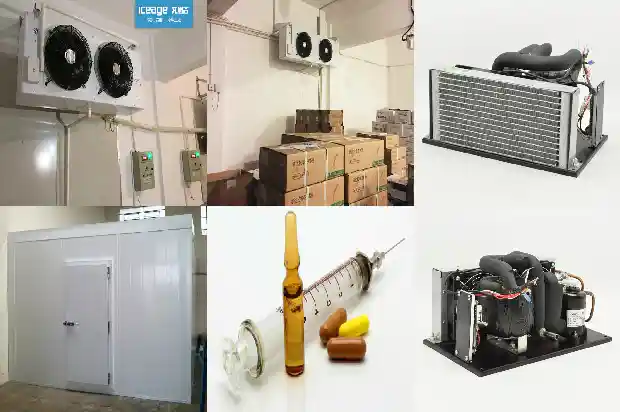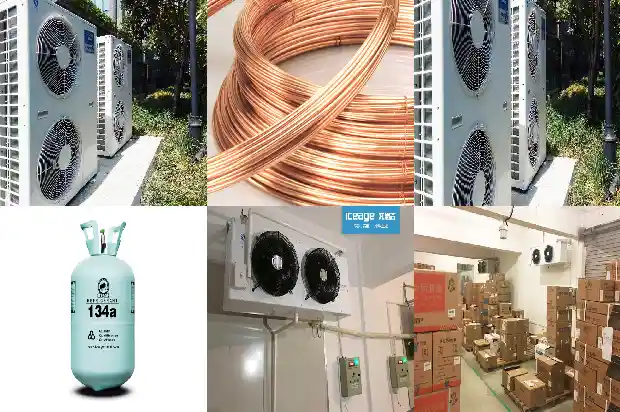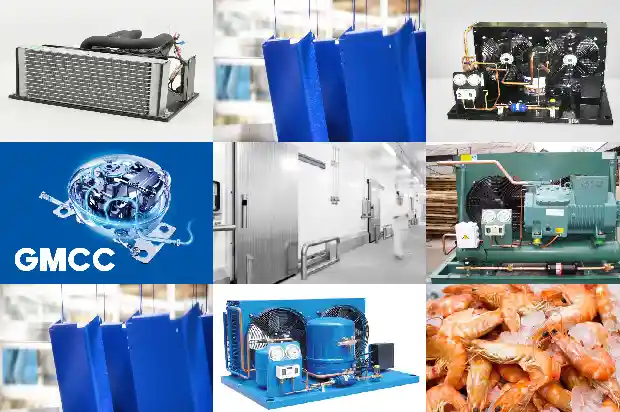Oxyacetylene Welding Operation Method for Refrigeration Pipes
2024-09-28
Gas welding, also known as brazing, is a method of connecting workpieces by using a solder (also known as an electrode) with a melting point lower than that of the workpieces. Through the high-temperature flame generated by the mixed combustion of combustible gas and supporting combustion gas in the welding torch, the workpiece is heated and the electrode is melted.
The welding system for general refrigeration maintenance is a small 2-4L oxyacetylene welding system, which consists of a welding torch, an oxygen cylinder, a gas cylinder, connecting hoses, and corresponding accessories such as inflatable bridges. Some welding torch kits are dual-purpose for welding and cutting, while others are single-purpose welding torches. The difference lies in the welding torch. A welding and cutting torch has three valve knobs and the torch head has two tubes of different sizes. By changing different nozzles, metal cutting and welding operations can be performed. While a welding torch only has two valve knobs and can only perform welding operations and cannot cut metal. Therefore, when selecting, you can choose according to your own usage situation.
As shown in the following picture (brass is the gas welding nozzle, and silver is the acetylene welding nozzle). There are five levels of welding nozzles from 1 to 5, mainly with different apertures. No. 1 is the smallest and No. 5 is the largest.
All connections, threads, valves, and pipelines of the oxygen cylinder must not be lubricated with any grease, nor can hands and rags stained with grease be used to operate the oxygen cylinder. Because when grease meets pure oxygen, it will undergo intense oxidation and spontaneous combustion, so this issue should be paid a little attention.
Looking at the following picture, the fuel valve is the knob that adjusts the amount of gas supply and directly determines the size of the flame.
The oxygen valve for the cutting line (referred to as the line valve). This valve is a special valve for cutting and is used to blow out the oxygen cutting line so that the high-temperature metal is quickly oxidized and flows away to achieve the purpose of separation and cutting. It is in a closed state during welding. Before ignition, make sure that all valves are in a closed state.
All valve handwheels of the welding torch face the handwheel. Clockwise turns close the valve and counterclockwise turns open the valve.
First, before ignition, the valves of the gas cylinder and oxygen cylinder should be opened first. Then, open the oxygen valve on the welding torch and discharge the air in the welding torch hose for 1 second and then close it.
Then, hold the welding torch in the right hand and a lighter in the left hand and ignite it as shown in the following picture. The welding torch nozzle should be upward and outward. Tilt the lighter to ignite the flame about 0.5 centimeters above the nozzle. The right hand then slowly turns on the fuel valve. At this time, the nozzle starts to burn.
The welding torch flame is in a natural diffusion combustion flame state similar to a lighter flame. The overall flame is soft and sways with the wind. Its root is completely attached to the nozzle and is not easily extinguished. If the flame is separated from the nozzle and there is a "whoosh, whoosh" sound, it means that the gas supply pressure is high. You can reduce the opening of the fuel valve and adjust the gas supply to ensure that the flame is in a natural diffusion state.
After the flame is adjusted, return the index finger to its original position and then slowly open the oxygen valve. At this time, as the oxygen gradually increases, the flame will gradually change from a bright and soft state to a blue and straight state.
After adding a certain proportion of oxygen, the golden yellow flame will disappear. Then, a yellow bright band will appear in the middle of the flame. At this time, the proportion of oxygen is small, and there is more remaining carbon in the fuel. By changing the oxygen proportion, the length of the yellow bright band can be changed until the yellow bright band disappears. The flame formed in this combustion state is called "carburizing flame". In daily welding, a slightly carburizing flame is generally used for pre-welding preparation.
On the basis of the carburizing flame, further increase the oxygen supply.
Further increase the oxygen supply in the neutral flame state. The bright white flame core of the flame gradually shrinks and turns light blue, accompanied by a "hissing" sound. At this time, the flame can be completely burned. This flame state is called "oxidizing flame". Because it burns cleanly, the oxidizing flame is generally used for welding products such as glass and plastic and is rarely used in metal welding. It has the largest oxygen consumption.
Welding quality analysis and countermeasures
Examples of poor welding
Corresponding measures
Slowly heat up. ①The welding fluidity is obviously not good. ②Incomplete welding, insufficient strength. ③Producing pores.
Readjust the flame and increase the flame temperature to reduce the heating time. Heat the base metal to a 豆沙色 (bean paste color).
Insufficient heating. Phenomenon: ①Defects such as pores are easily produced. ②Not easy to weld through, insufficient strength.
Insert the solder after heating the base metal to a sufficient temperature to ensure uniform heating.
Excessive heating. Phenomenon: ①The solder joint color is dark and black. ②The base metal bubbles.
Readjust the flame and reduce the flame temperature. Reduce the heating time.
Unclean base metal. Phenomenon: ①Producing pores or vacuum. ②Poor welding fluidity.
Remove dust, oil stains, and oxides on the surface of the base metal as required. Remove burrs and rust spots at the end of the base metal as required.
Copper tube brazing operation process
Common welding electrodes for refrigeration welding
Refrigeration welding uses oxyacetylene welding mainly to conveniently weld various non-ferrous metals. Different welding electrodes and fluxes will be used according to different welding materials.
Tin brass welding electrode: Tin brass welding electrodes are generally yellow, cylindrical and strip-shaped. They are used for welding iron pipes and copper pipes. Reliable welding can be achieved between copper pipes to copper pipes, copper pipes to iron pipes, and iron pipes to iron pipes. During the welding process, the welding electrode is preheated on the flame first and then dipped in flux for welding. Flux materials such as borax and copper welding powder are used.
Phosphorus copper welding electrode: Phosphorus copper welding electrodes are the most widely used welding electrodes in refrigeration. They have a copper-colored flat strip appearance. They are characterized by low melting point and good fluidity. They can be directly welded on copper pipes without adding additional flux. Phosphorus copper welding electrodes can also replace tin brass for welding iron pipes. Similarly, flux such as borax and copper welding powder needs to be added for welding. The weldable materials are the same as those of tin brass.
Copper-aluminum welding electrode: Now aluminum pipes are widely used in refrigeration equipment. Copper-aluminum welding electrodes are specially designed for welding copper pipes to aluminum pipes, aluminum pipes to iron pipes, and aluminum pipes to aluminum pipes in special environments. They are similar in appearance to solder, but there is flux in the middle of the welding electrode. No flux needs to be added during the welding process. Among all welding electrodes, copper-aluminum welding electrodes have the lowest melting point and can even be welded with high-power soldering irons. Of course, the price is also the highest.
Copper tube brazing operation process:
The welding system for general refrigeration maintenance is a small 2-4L oxyacetylene welding system, which consists of a welding torch, an oxygen cylinder, a gas cylinder, connecting hoses, and corresponding accessories such as inflatable bridges. Some welding torch kits are dual-purpose for welding and cutting, while others are single-purpose welding torches. The difference lies in the welding torch. A welding and cutting torch has three valve knobs and the torch head has two tubes of different sizes. By changing different nozzles, metal cutting and welding operations can be performed. While a welding torch only has two valve knobs and can only perform welding operations and cannot cut metal. Therefore, when selecting, you can choose according to your own usage situation.
As shown in the following picture (brass is the gas welding nozzle, and silver is the acetylene welding nozzle). There are five levels of welding nozzles from 1 to 5, mainly with different apertures. No. 1 is the smallest and No. 5 is the largest.
All connections, threads, valves, and pipelines of the oxygen cylinder must not be lubricated with any grease, nor can hands and rags stained with grease be used to operate the oxygen cylinder. Because when grease meets pure oxygen, it will undergo intense oxidation and spontaneous combustion, so this issue should be paid a little attention.
Looking at the following picture, the fuel valve is the knob that adjusts the amount of gas supply and directly determines the size of the flame.

The oxygen valve for the cutting line (referred to as the line valve). This valve is a special valve for cutting and is used to blow out the oxygen cutting line so that the high-temperature metal is quickly oxidized and flows away to achieve the purpose of separation and cutting. It is in a closed state during welding. Before ignition, make sure that all valves are in a closed state.
All valve handwheels of the welding torch face the handwheel. Clockwise turns close the valve and counterclockwise turns open the valve.
First, before ignition, the valves of the gas cylinder and oxygen cylinder should be opened first. Then, open the oxygen valve on the welding torch and discharge the air in the welding torch hose for 1 second and then close it.

Then, hold the welding torch in the right hand and a lighter in the left hand and ignite it as shown in the following picture. The welding torch nozzle should be upward and outward. Tilt the lighter to ignite the flame about 0.5 centimeters above the nozzle. The right hand then slowly turns on the fuel valve. At this time, the nozzle starts to burn.
The welding torch flame is in a natural diffusion combustion flame state similar to a lighter flame. The overall flame is soft and sways with the wind. Its root is completely attached to the nozzle and is not easily extinguished. If the flame is separated from the nozzle and there is a "whoosh, whoosh" sound, it means that the gas supply pressure is high. You can reduce the opening of the fuel valve and adjust the gas supply to ensure that the flame is in a natural diffusion state.
After the flame is adjusted, return the index finger to its original position and then slowly open the oxygen valve. At this time, as the oxygen gradually increases, the flame will gradually change from a bright and soft state to a blue and straight state.
After adding a certain proportion of oxygen, the golden yellow flame will disappear. Then, a yellow bright band will appear in the middle of the flame. At this time, the proportion of oxygen is small, and there is more remaining carbon in the fuel. By changing the oxygen proportion, the length of the yellow bright band can be changed until the yellow bright band disappears. The flame formed in this combustion state is called "carburizing flame". In daily welding, a slightly carburizing flame is generally used for pre-welding preparation.
On the basis of the carburizing flame, further increase the oxygen supply.

Further increase the oxygen supply in the neutral flame state. The bright white flame core of the flame gradually shrinks and turns light blue, accompanied by a "hissing" sound. At this time, the flame can be completely burned. This flame state is called "oxidizing flame". Because it burns cleanly, the oxidizing flame is generally used for welding products such as glass and plastic and is rarely used in metal welding. It has the largest oxygen consumption.
Welding quality analysis and countermeasures
Examples of poor welding
Corresponding measures
Slowly heat up. ①The welding fluidity is obviously not good. ②Incomplete welding, insufficient strength. ③Producing pores.
Readjust the flame and increase the flame temperature to reduce the heating time. Heat the base metal to a 豆沙色 (bean paste color).
Insufficient heating. Phenomenon: ①Defects such as pores are easily produced. ②Not easy to weld through, insufficient strength.
Insert the solder after heating the base metal to a sufficient temperature to ensure uniform heating.
Excessive heating. Phenomenon: ①The solder joint color is dark and black. ②The base metal bubbles.
Readjust the flame and reduce the flame temperature. Reduce the heating time.
Unclean base metal. Phenomenon: ①Producing pores or vacuum. ②Poor welding fluidity.
Remove dust, oil stains, and oxides on the surface of the base metal as required. Remove burrs and rust spots at the end of the base metal as required.
Copper tube brazing operation process
Common welding electrodes for refrigeration welding
Refrigeration welding uses oxyacetylene welding mainly to conveniently weld various non-ferrous metals. Different welding electrodes and fluxes will be used according to different welding materials.
Tin brass welding electrode: Tin brass welding electrodes are generally yellow, cylindrical and strip-shaped. They are used for welding iron pipes and copper pipes. Reliable welding can be achieved between copper pipes to copper pipes, copper pipes to iron pipes, and iron pipes to iron pipes. During the welding process, the welding electrode is preheated on the flame first and then dipped in flux for welding. Flux materials such as borax and copper welding powder are used.
Phosphorus copper welding electrode: Phosphorus copper welding electrodes are the most widely used welding electrodes in refrigeration. They have a copper-colored flat strip appearance. They are characterized by low melting point and good fluidity. They can be directly welded on copper pipes without adding additional flux. Phosphorus copper welding electrodes can also replace tin brass for welding iron pipes. Similarly, flux such as borax and copper welding powder needs to be added for welding. The weldable materials are the same as those of tin brass.
Copper-aluminum welding electrode: Now aluminum pipes are widely used in refrigeration equipment. Copper-aluminum welding electrodes are specially designed for welding copper pipes to aluminum pipes, aluminum pipes to iron pipes, and aluminum pipes to aluminum pipes in special environments. They are similar in appearance to solder, but there is flux in the middle of the welding electrode. No flux needs to be added during the welding process. Among all welding electrodes, copper-aluminum welding electrodes have the lowest melting point and can even be welded with high-power soldering irons. Of course, the price is also the highest.
Copper tube brazing operation process:
- Clean the oxide film and oil stains on the outer surface of the copper tube joint and the inner surface of the pipe fitting joint.
- Insert the copper tube into the pipe fitting, insert it to the end and rotate it to maintain a uniform gap.
- Use a gas welding flame to uniformly heat the joint until it reaches the brazing temperature. At this time, the temperature should be about 650℃ - 750℃. The color of the heated part is cherry red.
- When the brazing heating temperature is reached, feed the flux. (When connecting copper tubes and brass parts, flux is not necessary when connecting copper tubes and copper fittings.)
- Use the brazing filler metal to contact the joint that has been heated to a high temperature. When the temperature at the copper tube joint can quickly melt the brazing filler metal, it indicates that the joint has reached the brazing temperature as tested. Then, while heating, continuously add brazing filler metal until the brazing seam is filled to form a weld. At this time, the flame cannot be directly heated against the welding filler metal.
- Remove the flame and let the joint cool and crystallize in a static state.
- Clean up the residue of the joint and let the weldment cool naturally.
Related Articles
- Instructions for Welding and Drainage in the Installation of Refrigeration Equipment Pipelines
- Welding Equipment Used in Refrigeration System Maintenance
- Multi-split air conditioner: Nitrogen charging for welding, pressure maintaining, vacuuming and refrigerant charging
- Experience Sharing on Refrigeration Welding Operations
- Essential for Maintenance! Parameters and Phenomena of Normal Operation of Refrigeration and Heating Systems
- What is the Correct Operation Method of the Distribution Box during Cold Storage Installation?
- Operation of Screw - type Water - cooled Chiller Units
- Considerations in Selecting Packaged Air Conditioners and Their Heat Recovery Operations
- Common Malfunctions in the Operation of Cold Storage
- What Are the Three Essential Conditions for the Safe Operation of the Refrigeration System?
- Common Issues in Chiller Operation and Solutions
- Operations and Precautions for Multi - split Air Conditioners: Blowing Debris, Air Tightness, Vacuum Drying, and Refrigerant Charging
- What Should Be Done When the Condenser Fan Doesn't Rotate During Operation?
- Maintenance and Operation of Freezing and Cold Storage Warehouses
- Cooling Operation of Ammonia Refrigerated Cold Storage
- Water-cooled Screw Chiller: Operation and Maintenance
- Defrosting Operation Modes of Refrigeration Equipment and Its Control Components
- Startup and Shutdown Operations of Screw Chiller
